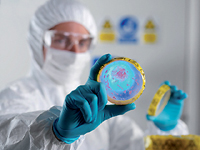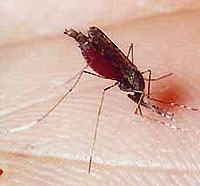To protect yourself from legionelleze is not so easy. His pathogen is not afraid of chlorine, which usually disinfect water. So what to do? First of all, know what Legionella is afraid, and then take appropriate prevention measures.
Content
 Legionell, or so-called «Legionnae disease» - This is an infectious disease, which often causing epidemic among the population of different countries. The disease was first recorded in 1976 in Philadelphia, when 30 American veterans of World War II were killed from a previously known virus. The rapid spread of the bacterium in Europe made it forced and explore the disease that is considered fatal.
Legionell, or so-called «Legionnae disease» - This is an infectious disease, which often causing epidemic among the population of different countries. The disease was first recorded in 1976 in Philadelphia, when 30 American veterans of World War II were killed from a previously known virus. The rapid spread of the bacterium in Europe made it forced and explore the disease that is considered fatal.The disease occurs sharply and quickly and, according to statistics, approximately 12% ends with a fatal outcome. According to the statistics of outbreaks of diseases in the United States, the main method of mass infection of a person from water supply systems - air-droplege, from aerosols formed in risk areas: shower rooms, hospitals, pools, gyms, barracks, baths and residential premises, car wash, water ships , in the cooling towers.
At water temperature over 20 degrees, fountains, garden irrigation systems and the pools themselves are also attributed to risk zones.
There are 43 types of Legionella varieties that are common in nature everywhere. Their colonies usually multiply at a temperature of 20-50 degrees in fresh water, especially in biofilms. If the design and nature of water supply systems do not provide sufficient sterility, in such systems they can form and multiply a colony of Legionella Pneumophila.
The peculiarity of the pathogen is its resistance to the effects of the most common disinfectant - chlorine, especially in the case of introducing into AmeB or in reproduction in biofilms on the inner surface of pipelines and other elements of water supply systems.
This means that the traditional method of protecting water in the case of Legionella does not work. The causative agent is resistant to elevated temperatures. The reproduction of the pathogen is stopped outside the temperature range of 20-55 degrees.
Periodic prevention measures
- thermal processing of water supply systems;
- irradiation of the inner surfaces of water supply systems (tanks-drives, boilers) and water itself with rigid ultraviolet radiation;
- Electrochemical effect on water, anodic oxidation, water saturation by copper and silver ions.
From the number of periodic prevention measures, the most practical due to simplicity and accessibility is the thermal processing of water supply systems.
Measures of constant prevention
- maintaining water temperature for cold water systems below 20 degrees, and for hot water supply - above 55 degrees all over the way from water treatment places and thermal points to the consumer;
- The use of the design of water supply systems that reduces the number and length of deadlock, where, with minor volumes of water consumption, cold water can be stimple to heat and heat hot water and cool;
- Selection of materials for elements of water supply systems, overwhelming Legionella Pneumophila.
Important for the application of constant prevention measures have the residence potential of Legionell Pneumophila at elevated temperatures:
- 50 degrees Celsius - Bacteria survives, but it does not multiply;
- 55 degrees - bacteria die for 5-6 hours;
- 60 degrees - bacteria die for 32 minutes;
- 65 degrees - bacteria die in 2 minutes;
- 70-80 degrees - Instant unconditional disinfection.
In terms of the selection of material for elements of water supply systems, a special role belongs to copper and copper alloys that have bacteriostatic and bactericidal action in relation to a variety of microorganisms, in T. C. Legionella Pneumophila. Copper pipelines, especially in areas near the consumer, may be an additional and last protection in those numerous cases when there is a stagnation of water and an increase in the temperature of more than 20 degrees or its decrease below 50 degrees.
In turn, such materials of pipelines, boilers, drives of drives, like carbon steel, polymers (polybutylene, PVC and CPVH, polyethylene, ethylene propylene and latex) promote the development of Legionella Pneumophila colonies and growth on the inner surface of biofilm pipelines, where these bacteria live.
This should be interesting to owners of private houses with an individual water supply system with storage tanks.
In Russia, it was long to refer to the possibility of infection with legionelles as something unlikely. In July 2007 (when in g. The upper pyshma of the Sverdlovsk region occurred a surge of pulmonary pneumonia caused by the pathogen Legionella Pneumophila, - Legionelles, or the so-called «Legionnae disease») It became clear that no one will be protected from the deadly disease, unless not to take special measures. Measures are simple but necessary.









